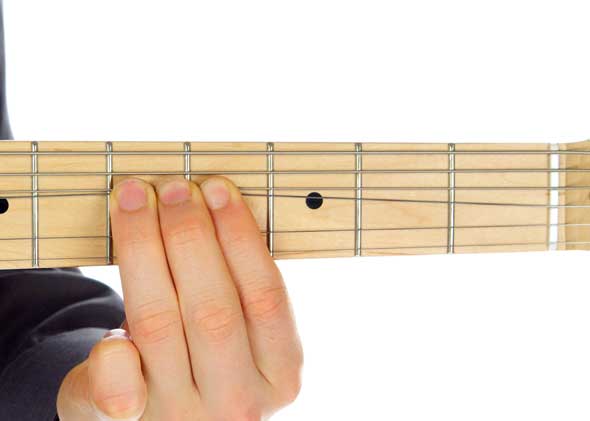
Advanced Lead Guitar Techniques
The bend, release bend and vibrato are techniques that will prove to be more difficult than the previous techniques discussed and will require a great deal more practice to develop.
The Bend
The bend is achieved by bending a string with the left hand in the direction of the adjacent strings, causing the note to rise in pitch. This is done with the left hand finger which is fretting the note. This technique is demonstrated in the following example.
In example 40, the note on the seventh fret of the 3rd string is bent with the third finger of the left hand. In order to bend the note successfully, bend the string with the help of the second finger as well. This can be seen in the accompanying photograph. The symbol "B" and a curved line indicate a bend.


Play the note on the seventh fret of the 3rd string

The third finger bends the string upwards, with the help of the second finger
Example 41 is a simple lick played within pattern one in the key of C.

Example 42 is a similar lick to example 41, but bends are added..

The Release Bend
The release bend is played by first bending the note indicated with the left hand, plucking the string whilst bent, then returning the string to its normal position. If played correctly the release bend creates a drop in pitch from a higher note to a lower note.
In order to play example 43, bend the note on the 3rd string, seventh fret with the third finger of the left hand. Pick the 3rd string with the right hand while the string is bent. Immediately after striking the string and still maintaining pressure on the note against the fret board release the string carefully to its normal position. The release bend is indicated by a curved line and the symbol "R".


Bend the note on the seventh fret of the 3rd string.

After the note is played, release the string to its normal position.
Example 44 is a simple lick played within pattern one in the key of C.

Example 45 is a similar lick to example 44, but the release bend is used.

Double-Note Bends
Another popular way of using a bend is to bend a note whilst playing another note at the same time. In the following example notes within pattern one on the second and third string are played at the same time. Whilst holding the second string note with the fourth finger of the left hand, the third finger bends the note on the seventh fret of the third string.


The double-note bend is featured in the next example. In order to play all the doublenotes it will be necessary to keep the fourth finger of the left hand fretted throughout the entire lick.

The next lick combines the bend and release bend with a double-note.

A variation of the double-note bend is to bend the note, hold it in position and then play the second note. The bent note and the normal note need to sustain together. A bracket is shown on the tablature to show the first note is held whilst the second note is played.

The next lick uses both types of the double-note bend. The fourth finger of the left hand remains fretted throughout the entire lick.

The next lick requires the fourth finger of the left hand to bar the first and second strings.

Vibrato
This lesson introduces another popular lead guitar technique used frequently throughout a lick or solo, the vibrato. The vibrato is another technique controlled with the left hand finger which is fretting the note. This technique involves moving the string rapidly back and forth in the direction of the adjacent strings as the left hand finger is fretting the note.
In the following example vibrato is applied to the note on the ninth fret of the 3rd string. Vibrato is indicated by a wavy line above the note as shown in example 52.


Example 53 is a simple lick played within pattern one in the key of C.

Example 54 is the same lick as example 53, but vibrato is used.

Example 54 is the same lick as example 53, but vibrato is used.

The two extra notes in pattern one are utilised in the following example.

Another optional fingering for the Country lead guitar pattern one is shown in the following example. The only difference with this pattern is the extra note on the first string and the extra note on the second string. The example shown is in the key of C.

The next example features the two extra notes shown in the previous diagram.

Combining Lead Guitar Techniques
Example 57 is in the key of C and features a double-note hammer-on.

The next example is in the key of D.


Example 59 is in the key of Bb and introduces a double-note slide.

